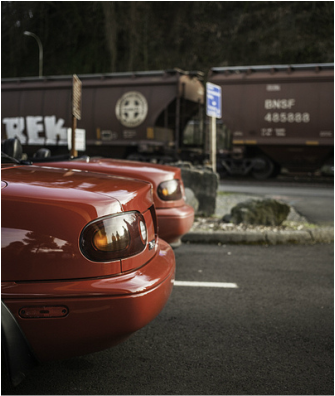In case you’ve already forgotten, both part 1 and 2 of the stick shift article series detailed the functionality of a manual car and how to start and move forward in a manual vehicle. For those who have been practicing and driving only in forward motion ;), let us now close the loop and come full circle; let’s learn how to put a manual transmission car in reverse!
So, let’s talk about going backwards. In all vehicles (manual & automatic), there is a specific gear with the symbol “R” for reverse. This gear, when engaged, allows the vehicle to progress backwards when the gas is applied. The “reverse” gear is easily identified in automatic cars as it’s laid out in a sequential order on the gear lever. This same gear does take some detective work in order to engage in manual transmission cars. Where is the “R”? Imagine your elementary math teacher asking you that question. The answer actually varies depending on how many gears your transmission has. If you own a 5-speed manual, it’s very common to find your reverse (R) gear at the lower far right corner (furthest away from the driver) of the gearbox. If you own a 6-speed manual or a European car, then your reverse gear can be found in two separate locations depending on the make and model of your vehicle: 1) top left corner, adjacent to the 1st gear 2) bottom right corner, adjacent to the 6th gear. Now that you have a general idea as to where the reverse gear is, let’s go into a bit more detail regarding how to drive the car when it’s in reverse. The initial input of the reverse gear is similar to how you would engage all other gears… with the clutch depressed, trigger the reverse lever and slide the shifter into the appropriate slot. Starting the vehicle in reverse requires the same principle as other gears; the trick is to find the ideal “catch-point” where by you release the clutch foot slowly until you feel as if the car is about to turn off. It is during that exact moment when you move your right foot from the brake to the accelerator and apply a bit of gas. At this point, you have a few options: 1. Completely take your left foot off of the clutch and apply ample gas for a smooth backwards acceleration. This method works when you are on a flat surface and there are no objects or people behind you. 2. There’s an alternative method where the driver relies on the clutch as a means to control the acceleration speed of the car. The idea is to provide ample gas to get the car to initiate the motion. As the vehicle picks up momentum, the driver lightly withdraws his/her left foot away from the clutch, but without fully taking it off the pedal. If the car picks up too much speed, simply depress the clutch slowly and the car will begin to slow down. (Note: Although quite convenient, we recommend avoiding this method as applying too much stress on the clutch can cause the clutch to wear out or burnout). So there you go young grasshoppers, the master has passed down the art of how to drive a manual / stick shift. Of course there are still plenty of tricks to be discovered, we will leave that for future posts and for you to explore on your own. As always, we leave you with the words of wisdom that practice makes perfect and each vehicle is different. So spend some time to bond with your “Mia”. Have fun and be safe! P.S. Hey Mazda, we’d love to get our hands on the 2016 Mazda Miata to give it a proper MP review and play match maker with the younger sexier Mia! by ManPossible Photo used under CC from ryan lovelace
0 Comments
Your comment will be posted after it is approved.
Leave a Reply. |
